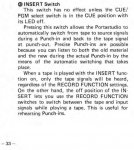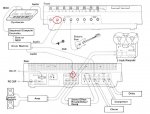famous beagle
Well-known member
Ok, I have to admit, I don't think I've ever fully understood the routing on most 4-track machines. Way back in the day when I started on a Fostex X-26, I never bothered to use the monitor section; I always just monitored my tracks off the main mix. In other words, as soon as I had recorded something on a track, I would just put that channel in the "tape" or "remix" setting and monitor that. I never used the monitor jacks on the back; I always just used the Line Out ones. This worked fine for me, the main drawback being that I had to plug into a new input every time I wanted to record a new track.
And this has really kind of been the way I've worked ever since.
But now I've finally got my Tascam 246 up and running and am ready to record some tunes on it. And I want to understand it fully, but I have some questions. This machine has a fairly sophisticated mixer section compared to my 4-tracks of the past. I'm hoping some of y'all can clue me in. I have the manual, have read it all, and am trying to understand it, but it's not answering all my questions.
1. Is there a way to hear effects added to a track (tape play back) while monitoring the cue mix? In the manual when it discusses recording the first track and overdubbing the second track, it only mentions listening to the monitor submixer (the MONITOR GAIN and PAN knobs). It doesn't mention anything about effects at all. (Actually, it doesn’t even mention anything about effects in the “Remix or Mixdown” procedure either!)
If I'm understanding the manual correctly (and if all of my experiments have been correct), I'm guessing that you're normally supposed to complete all your tracking and overdubbing with dry signals. Is this correct?
2. Is there a way to hear, say, reverb on a vocal as you record it but not print it to tape? I can’t seem to find a way to do it.
I think this was one of the reasons I shied away from using the monitor mix way back in the day. I couldn’t find a way to hear effects, and I wanted to hear a little verb or something!
I’m sure I’ll have some other questions eventually, but these two are a good start.
Thanks to anyone who can help me!
And this has really kind of been the way I've worked ever since.
But now I've finally got my Tascam 246 up and running and am ready to record some tunes on it. And I want to understand it fully, but I have some questions. This machine has a fairly sophisticated mixer section compared to my 4-tracks of the past. I'm hoping some of y'all can clue me in. I have the manual, have read it all, and am trying to understand it, but it's not answering all my questions.
1. Is there a way to hear effects added to a track (tape play back) while monitoring the cue mix? In the manual when it discusses recording the first track and overdubbing the second track, it only mentions listening to the monitor submixer (the MONITOR GAIN and PAN knobs). It doesn't mention anything about effects at all. (Actually, it doesn’t even mention anything about effects in the “Remix or Mixdown” procedure either!)
If I'm understanding the manual correctly (and if all of my experiments have been correct), I'm guessing that you're normally supposed to complete all your tracking and overdubbing with dry signals. Is this correct?
2. Is there a way to hear, say, reverb on a vocal as you record it but not print it to tape? I can’t seem to find a way to do it.
I think this was one of the reasons I shied away from using the monitor mix way back in the day. I couldn’t find a way to hear effects, and I wanted to hear a little verb or something!
I’m sure I’ll have some other questions eventually, but these two are a good start.
Thanks to anyone who can help me!




